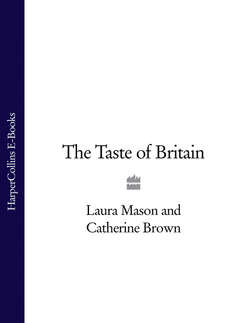Читать книгу The Taste of Britain - Hugh Fearnley-Whittingstall - Страница 124
HISTORY:
ОглавлениеPies have long been a favourite dish in Britain. The word has been in the language since at least the start of the fourteenth century. There are many recipes and almost any edible item seems at one time or another, to have been put between 2 layers of pastry and baked in the oven. Sweet fruit pies have been known since at least the seventeenth century, when Murrell (1638) gave recipes for ‘tarts’ of pippins (apples) flavoured with spices, orange zest and rose water; tarts of gooseberries or cherries are also cited. These were similar to modern pies, requiring a double crust, with sugar scattered over the surface before baking.
Fillings varied according to availability of fruit. Apple was probably the most popular, cherries were used in Kent and Buckinghamshire (Mabey, 1978). The blueberry pies now available in Dorset come within this genus of dishes, although their fruit filling is of a more recent tradition, imported in fact from North America (Davidson, 1991). The bilberry (Vaccinium myrtillus) is a bush that grows on acid soils in northern Europe. In Scotland it is known as whinberry (because it grows amidst whin, or gorse) or blaeberry and in Ireland, and in North-East England it is also known as blaeberry (blae means blue). Whortleberries are closely related.
Florence White (1932) records bilberry pies in Yorkshire. Bilberries were available for anyone who cared to pick them in many heathland areas along the south coast, in Wales, the Pennines and in Scotland. Gathering bilberries from the wild is time-consuming and the preserve of enthusiasts; recently, interest in using them as a local speciality in hotels has been rekindled in mid-Wales.
